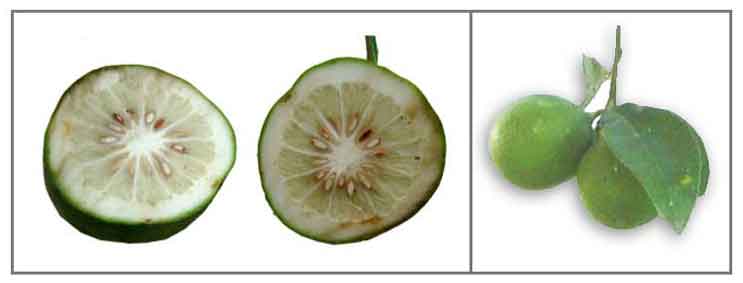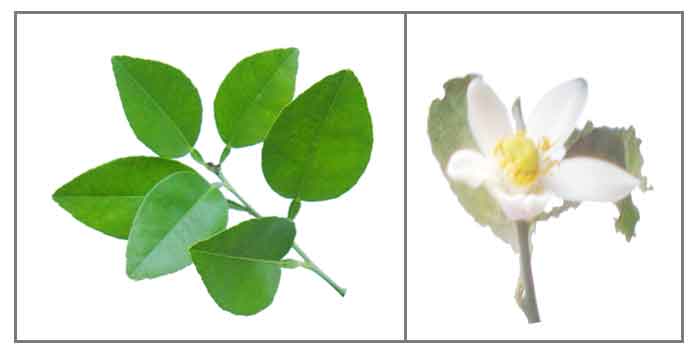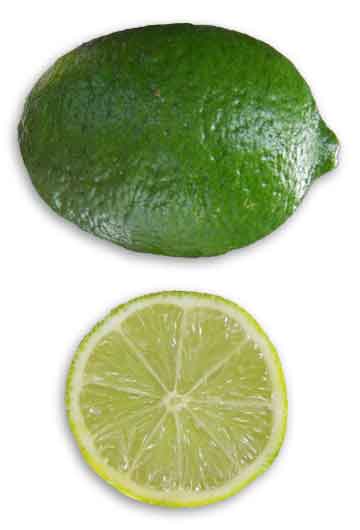|
 Botany Botany
Dayap is a small tree or shrub,
2 to 4 meters high, smooth throughout, branching with slender, solitary,
sharp spines 1 centimeter or less. Leaves are oblong-ovate to elliptic-ovate,
4 to 6 centimeters long. Petioles are 1 to 1.5 centimeters long, and narrowly winged. Racemes are short and axillary, bearing
few flowers which are white and fragrant. Petals are 4, oblong, 10 to 12 millimeters long.
The fruit is almost spherical, 3 to 5 centimeters in diameter, yellow, thin-skinned,
10-celled or more.
 Distribution Distribution
- Planted throughout the Philippines in settled areas.
- Native of the Indo-Malayan region.
- Now pantropic.
Constituents
- Lime juice in the West Indies contains 7.0 to 7.55 citric acid with small amounts of malic acid and tartaric acids, sugar up to 2.5%, pectin, and small amounts of salts.
-
Pulp yields 4.24% sugar;
0.66% ash, and the juice yields citric acid, 7.67%; vitamin C.
- Methanol extract yielded alkaloids, flavonoids, tannins saponins, steroids, cardiac glycosides, and reducing sugars.
(17)
- Essential oil yielded major constituents of limonene (58.4%), beta-pinene (15.4%) gamma-terpinene (8.5%), and citral (4.4%). (see study below)
(19)
- Study on fruit juice concentrates yielded alkaloids +. phenols +. flavonoids +. steroids +. terpenoids +. reducing sugar ++. saponins +. and cardiac glycosides ++. (35)
Properties
- Juice is regarded as antiseptic, tonic, antiscorbutic, astringent, diuretic.
- Root bark is febrifuge.
Parts utilized
Fruit, roots, bark, rind.
Uses
Edibility / Nutritional
- Makes a pleasant ade.
- Used as substitute for true lemon.
- Good source of vitamin C.
- In Malaya, the young dayap is preserved in syrup.
- Malays salt the fruit or preserve it in vinegar for use as pickle.
Folkloric
- In the Cordilleras, used to treat nausea, headache, fainting, malaria, and sore throat.
-
Nausea and fainting: Squeeze
rind near nostril for irritant inhalation.
- Decoction of roots used for dysentery; root-bark as febrifuge.
- Crushed leaves applied to forehead for headaches.
- Leaf decoction for eyewash and to bathe a feverish patient.
- Mouthwash and gargle for sore throat and thrush.
- Decoction of pounded leaves, with leaves of Areca catechu, drunk for stomachache.
- Externally, fresh juice is used to clean wounds; roasted, for chronic
sores.
- Juice used for irritation and swelling of mosquito bites.
- Poultice of leaves applied to ulcer wounds.
- Lime oil extracted by steam distillation of the fruit rinds used
for colds, sore throats, bronchitis, asthma.
- Used for arthritis, obesity,
cellulite and as tonic and astringent.
- Malays sip the fruit juice as a remedy for coughs.
- In Senegal and Sierra Leone, juice, sometimes mitigated by being mixed with oil, used as vermifuge.
- Poultice of leaves for skin diseases or on the abdomen after childbirth.
- In Malaya, root decoction used for dysentery.
- In Yucatan, root decoction used for gonorrhea.
- In southwest Nigeria, roots, bark, stem,
twigs, leaves and fruit used in treatment of malaria.
- In Pakistan, Northern Ethiopia, and Nigeria, plant and fruit used in the treatment of hypertension and other cardiac problems. (17)
Others
- As fumigant, steaming brew of leaves under the blanket.
- Aromatherapy
 Studies Studies
• Essential
oils / Antifungal: Study
on essential oils of three varieties of C. aurantifolia showed the plant
to be very rich in monoterpenes, with limonene its major compound. The
three extracts showed fungicidal inhibiting action to Phaeoramularia
angolensis and presents an alternative to chemical fungicides used for
Citrus fruit crops. (1)
• Antiproliferative / Anti-cancer:
Study of in vitro effects of several concentrations of lime juice
(CLJ) showed significant inhibition of proliferation of human breast
carcinoma cell line and assumes that protein components of the CLJ extract
may have anti-proliferative effects on tumor cell lines. (2)
• Antimicrobial:
Study investigating the
antibacterial effects of two plants extracts showed Citrus aurantifolia
showing promising broad spectrum antibacterial effects on human pathogens. (3)
• Antimicrobial: Antimicrobial study of bitter leaf (V. amygdalina) extract and lime (Citrus aurantifolia) juice against five organisms concluded both are potential antimicrobial agents. (11)
• Antiaflatoxigenic:
The essential oils of we medicinal plants were studied for
its inhibition of the toxigenic fungus Aspergillus parasiticus. Citrus
aurantifolia was found to inhibit both A. parasiticus and aflatoxin
production. The study suggests some medicinal plants may be potential
candidates for protection of food and feeds from toxigenic fungus growth
and subsequent AF contamination. (4)
•
Antiproliferative / Colon Cancer Prevention:
Study of the lime volatile oil of CA yielded 22 compounds,
D-limonene, D-dihydrocarvone among the major compounds. The oil
showed 78% inhibition of human colon cancer cells, DNA fragmentation
and apoptosis induction, results that suggested potential antiproliferative
benefits in colon cancer prevention. (5)
• Nephrolithiasis: Consumption of Citrus aurantifolia Swingle in idiopathic calcium renal stone with hypocitraturia increased the urine volume, pH level and total citrate value, total potassium and decreased the calcium ration to urine citrate with consequent decrease of renal stone recurrence. (6)
• Fertility Effects: Lime juice causes irregularity of the estrous cycle, partially blocks ovulation, and may possibly compromise fertility. (7)
• Toxicity Studies: Acute and subchronic toxicity studies of water extract from roots of Citrus aurantifolia in rats showed no signs of toxicity and no significant histopathological changes in the internal organs. (8)
• Weight Reduction / Decreased Food Intake / Limonene: Study investigated the effects of lime (Citrus aurantifolia) essential oils in reducing body weight, alone or in combination with ketotifen, an antihistamine drug that causes weight gain. Lime essential oil treatment displayed a reduction of body weight and food consumption in mice. In combination with ketotifen, there was significant suppression of weight gain, as well as decreased body weight. Oil analysis yielded 22 main components, with limonene (28.27%) as the principal one. (10)
• Antioxidant: Study showed both juice and peel demonstrated antioxidant properties. In contrast to lime peel, excessive consumption of lime juice seems not to be beneficial and may be harmful because of an inadvertent U dose response. (12)
• Antimicrobial: Study evaluated the antimicrobial potency of fruit plant (juice of the fruit and burnt rind known as "epa-ijebu") and the oil from steam distillation of the fruit. Study showed the antimicrobial potency of lime fruit is enhanced by the type of solvent used (ex: Schnapps or palm wine), indicating that active ingredients for antimicrobial and antifungal effect are released in conjunction with a particular solvent. (14) In a study of fruit juice concentrates for antimicrobial activity against five bacterial and three fungal strains, MIC and MBC values ranges from 12.5 to 200 µg/mL. Lemon and lime juice concentrates had lower MIC and MBC values with orange and tangerine showing the highest values. (35)
• Antioxidant / Cholinesterase Inhibitory Activity: Study evaluated the antioxidant capacity and acetylcholinesterase (AChE) and butyrylcholinesterase (BChE) inhibitory activity of peel essential oils from three Citrus species. Study yielded essential oils limonene, a-pinene, ß-pinene, y-terpinene, and linalyl acetate. C. aurantifolia oil showed the highest radical scavenging activity on ABTS assay and inhibited AChE more selectively. (15)
• Hypocholesterolemic: Study evaluated the effects of C. aurantifolia peel essential oil on serum cholesterol and triglycerides in Wistar rats. Results showed significant decrease in cholesterol and suggest a potential for cardiovascular risk reduction in humans. (16)
• Cardiovascular Effects / Fruits: Study evaluated the antihypertensive effect on three experimental hypertensive models in rats. Results showed the methanol extract of C. aurantifolia produces hypotensive and anti-hypertensive effect. (17)
• Spasmolytic Effect / Essential Oil: Study of essential oil of fruits (limes) showed spasmolytic effects on isolated rabbit jejenum, aorta and uterus. Activity was attributed to its major constituents:limonene, beta-pinene, gamma-terpinene, and citral. (see constituents above) (19)
• Antibacterial: In a study of eleven medicinal plants of the Cordillera Region in the Philippines, four plants showed antibacterial activity: A. dammara, E. triplenerve, C. aurantifolia, and T. diversifolia. C. aurantifolia juice was the most effective with inhibition of E. coli, B. subtilis and S. aureus at lower concentration of 62.5µg/ml. (20)
• Antifertility Potential / Partial Blockage of Ovulation / Lime Juice: Study evaluated the effect of lime juice on histomorphological alterations of the ovaries and uterus of cyclic Sprague-Dawley rats. Results showed possible compromise of fertility with reduction of ova shed and irregularity in the histology of the reproductive organs (uterus and ovaries). (21)
• Antihypertensive Effect: Study evaluated the effects of an aqueous extract of CA on arterial blood pressure and on isolated heart and aorta activities. Results showed a dose dependent and significant decrease in rabbit blood pressure and both negative inotropic and chronotropic effects on heart contractile activity in albino Wistar rats. Results suggest antihypertensive activity which could be related to cardiodepression and vasorelaxation, and possible activation of the endothelial NOS by the active principles. Â Â (22)
• Arrest and Apoptosis in Human Gastric Cancer AGS Cells / Flavonoids: Study evaluated the anti-cancer effect of flavonoids isolated from C. aurantium in human gastric cancer AGS cells. Results showed an antiproliferation effect on AGS cells through both G2/M arrest via modulation of cell-cycle-related proteins, cyclin B1, cdc 2, and cdc 25c and triggering apoptosis via upregulation of caspase-3 activity and cleavage of PARP. (23)
• Male Antifertility Effect: Study evaluated the effect of various dosages of CA treatment on fertility promoters and indices in male albino wistar rats. Results showed antifertility potential with significant lowering effects on LH, significant increase in testosterone, significant decrease in motility and sperm morphology. (24)
• Anxiolytic Effect on Preoperative Anxiety / Blossoms: A randomized double-blind study of 30 patients evaluated the anxiolytic effect of C. aurantium blossom on preoperative anxiety. Results showed CA blossom may be effective in reducing preoperative anxiety before minor surgery. (25)
• Anti-Anxiety Effect / Fluoxetine Potentiation: Study investigated the effect of C. aurantium essential oil on anxiety using anxiety using elevated plus maze test. and its interference with the serotonergic pathway. Results showed CA essential oil can reduce anxiety in male mice, and as evidenced by fluoxetine potentiation the herb may express its effect, in part, via the serotonergic system. (26)
• Acute and Subchronic Toxicity Studies / Roots: Study of water extract from the roots of C. aurantifolia in both male and female rats showed no acute or subchronic toxicities. A dose of 1,200 mg/k/d caused a significant increase in liver enzymes within normal range, but no significant histopathological change in internal organs. (27)
• Comparative Antioxidant Activity / Ripe and Unripe Fruits: Study evaluated the in-vitro antioxidant activities of both unripen and ripen C. aurantifolia fruits by DPPH and TAC assay. Results showed unripe juices showed more antioxidant activity compared to ripen juices. The lower antioxidant activity of ripe fruits may be due to possible reduction in ascorbic acid and total phenolic content during ripening. (28)
• Aromatherapy / Blossom Oil During First Stage of Labor: Study evaluated the efficacy of aromatherapy with Citrus aurantium oil in reducing anxiety during first stage of labor. There significant lowering in levels of anxiety at dilation of 3-4 and 6-8 cms with aromatherapy. Results suggest a simple, inexpensive, noninvasive and effective intervention for reducing anxiety during labor. (29)
• Additive Antihyperglycemic Effect in Garlic and Lime Combination: Study in STZ-induced diabetic rats showed significant and dose-dependent decrease in plasma glucose levels. (30)
• Effect in Paroxetine Induced Hyponatremia: Study evaluated the effect of CA juice in paroxetine induced hyponatremia in albino mice. Results showed hypernatremic effects and reversal of alterations in serum proteins, cholesterol, triglycerides, sodium, potassium and calcium back to normal on treatment with CA juice. (31)
• Anthelmintic Against Heligmosomoides Bakeri / Fruit Peels: Study evaluated the in vitro ovicidal and larvicidal properties of extracts of C. aurantifolia fruit on eggs and first stage larvae of Heligmosomoides bakeri. All extracts showed significant anthelmintic effect. (32)
• Nephroprotective: Study evaluated the protective role of C. aurantium against gentamicin induced renal damage. Results showed nephroprotective activity attributed to its known flavonoid contents and antioxidant properties. (33)
• Prevention of Ketotifen-Induced Weight Gain / Lime Essential Oils: Study evaluated the effects of lime essential oils in reducing body weight, alone or in co-administration with ketotifen, an antihistaminic drug that causes weight gain using a mice model. Results showed lime essential oil plays an important role in weight loss and has the potential in the treatment of drug-induced obesity and related diseases. Â Â (34)
• Antioxidant Activity: In a study of fruit juice concentrates for radical scavenging activity, lime juice concentrate showed (% inhibition: mg/mL) of 2.85 ± 0.20 (0.5) and 6.25 ± 0.06 (1.0). Ferric-reducing antioxidant potential (FRAP) value showed 173.25 ± 0.25 µmol.L Fe(II)/g of extract. Ascorbic acid showed 312.88 ± 5.61. (35)
• Antibacterial Synergism with
Honey: Study evaluated the synergistic antibacterial potentials of Citrus aurantifolia and honey against bacterial isolated from sputum. Morphological exam showed the bacterial isolates to belong to genera S. aureus, Streptococcus spp, P. aeruginosa, K. pneumonia, and E. coli. Results suggest lime and honey showed more activity than when used singly. (36)
• Abortifacient with No Teratogenic Effect: Study evaluated the effect of lime juice on the fetal parameters of Sprague-Dawley rats. Results showed aqueous lime juice had a abortifacient effect as evidenced by significant reduction of fetuses of treated rats.but no obvious teratogenic effect. Authors recommend that lime juice should not be consumed during pregnancy. (37)
Availability
Commercial cultivation.
Extracts, essential oils and supplements in the cybermarket.
|


![]()

